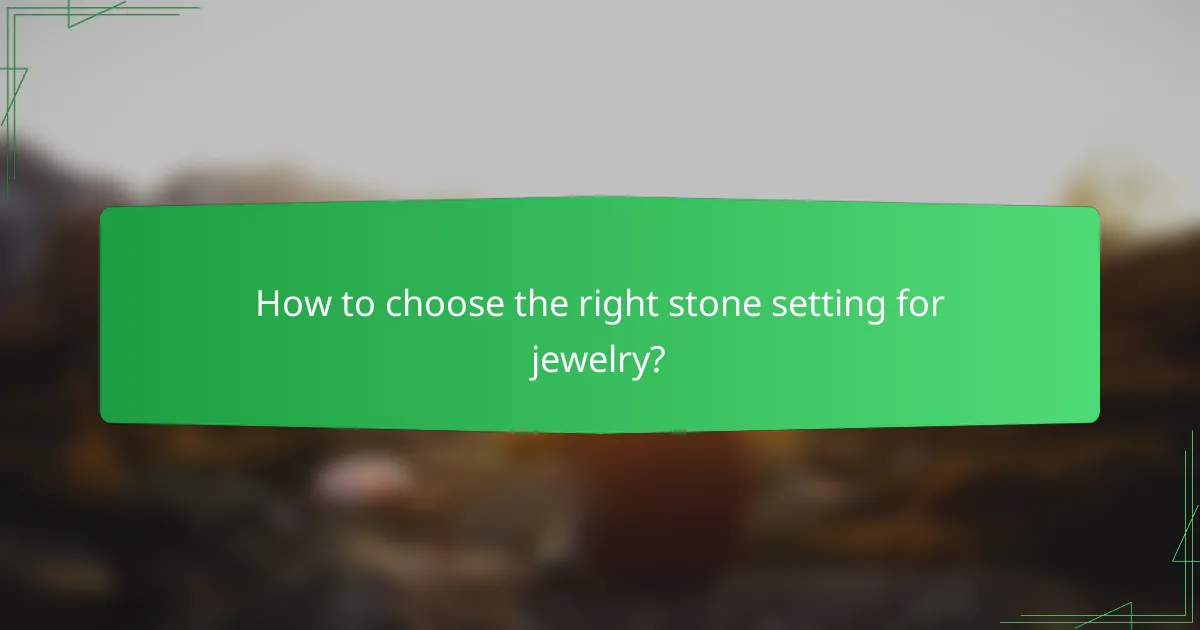When selecting a stone setting for jewelry, it’s essential to consider both the visual appeal and the security of the gemstone. Prong placements strategically hold stones in place while maximizing their visibility, whereas bezel settings encircle the gems with metal, offering both protection and an elegant frame. Understanding these techniques ensures that your jewelry is not only beautiful but also durable for everyday wear.

How to choose the right stone setting for jewelry?
Choosing the right stone setting for jewelry involves balancing aesthetics, security, and the type of gemstone. Consider how the setting enhances the stone’s appearance while ensuring it remains securely mounted for everyday wear.
Prong settings for maximum light exposure
Prong settings are designed to hold a gemstone in place using small metal claws, allowing light to enter from multiple angles. This exposure enhances the stone’s brilliance and sparkle, making it ideal for diamonds and other transparent gems.
When selecting a prong setting, consider the number of prongs; typically, four or six prongs are common. More prongs can provide additional security but may slightly reduce light exposure. Ensure the prongs are well-crafted to avoid snagging on clothing or other materials.
Bezel settings for secure stone protection
Bezel settings encircle the gemstone with a metal rim, offering superior protection against chips and damage. This type of setting is particularly suitable for softer stones or those prone to breakage, such as opals or turquoise.
While bezel settings may limit light exposure compared to prong settings, they provide a sleek, modern look and can be customized in various designs. Ensure the bezel is snug but not overly tight, allowing for a secure fit without compromising the stone’s integrity.
Comparison of settings for different gemstones
Different gemstones require different settings based on their hardness, shape, and desired appearance. For instance, softer stones like pearls benefit from bezel settings for protection, while harder stones like sapphires can be showcased effectively in prong settings.
Here’s a quick comparison of common settings:
- Diamonds: Best in prong settings for maximum sparkle.
- Emeralds: Prefer bezel settings due to their fragility.
- Rubies: Versatile; can work well in both prong and bezel settings.
Always consider the lifestyle of the wearer; active individuals may prefer more secure settings to prevent loss or damage to their gemstones.

What are prong placements in stone settings?
Prong placements in stone settings refer to the strategic positioning of metal prongs that hold gemstones securely in place. Proper prong placement is crucial for maximizing a stone’s visibility while ensuring its stability and protection from damage.
Standard prong placements for round stones
Standard prong placements for round stones typically involve four or six prongs, arranged evenly around the stone. Four-prong settings offer a minimalist look, allowing more light to enter the stone, while six-prong settings provide added security, making them ideal for everyday wear.
When choosing between these options, consider the stone’s size and the likelihood of it being knocked or scratched. For larger stones, six prongs may be more suitable to prevent any movement, while smaller stones can often be safely secured with four prongs.
Unique prong placements for fancy shapes
Unique prong placements for fancy-shaped stones, such as oval, pear, or marquise, often require customized settings to accommodate their specific contours. These placements may include additional prongs or varied angles to ensure the stone is held securely without compromising its shape.
For example, a marquise stone may benefit from a V-shaped prong at each end to protect its pointed tips, while an oval stone might use elongated prongs that follow its curves. When designing settings for fancy shapes, always prioritize the stone’s protection and visibility to enhance its overall appearance.

How do bezel settings work?
Bezel settings secure a gemstone by encircling it with a metal rim, providing a protective and aesthetically pleasing mount. This method not only holds the stone in place but also enhances its visual appeal by framing it within the jewelry piece.
Types of bezel settings: full vs. partial
Full bezel settings completely encase the stone, offering maximum protection and a sleek look. This style is ideal for softer gemstones, as it minimizes the risk of chipping or damage.
Partial bezel settings, on the other hand, leave part of the stone exposed, allowing more light to enter and enhancing its brilliance. This option is suitable for harder stones, where the risk of damage is lower, and it can create a more dynamic visual effect.
Advantages of bezel settings for durability
Bezel settings are renowned for their durability, making them a popular choice for everyday wear. The surrounding metal shields the stone from impacts and scratches, significantly reducing the likelihood of losing the gem.
Additionally, the secure mounting of bezel settings means that they are less prone to snagging on clothing or other surfaces, which can be a common issue with prong settings. This feature makes bezel settings particularly appealing for active individuals or those who prefer low-maintenance jewelry.

What are the best practices for secure mounting?
To ensure secure mounting of stones, it is essential to use appropriate techniques and materials that prevent stones from loosening or falling out. Proper prong placement, bezel settings, and regular inspections can significantly enhance the durability and safety of the mounted stones.
Techniques for ensuring stone security
Effective techniques for securing stones include using the right type of setting, such as prong or bezel settings, which provide different levels of protection. Prong settings allow light to enter the stone while holding it firmly in place, whereas bezel settings encircle the stone, offering a more secure and protective mount.
Additionally, ensure that prongs are properly shaped and positioned to cover the stone’s girdle without obstructing its view. Regularly checking the tightness of the prongs and the integrity of the bezel can help maintain security over time.
Common mistakes in stone mounting
One common mistake is not using enough prongs or inadequate bezel coverage, which can lead to stones becoming loose. It is crucial to assess the size and shape of the stone to determine the appropriate number of prongs or the depth of the bezel needed for secure mounting.
Another frequent error is neglecting regular maintenance checks. Stones should be inspected periodically for any signs of wear or loosening, especially after exposure to harsh conditions or impacts. This proactive approach can prevent costly repairs or loss of stones.

How does stone setting affect jewelry pricing?
Stone setting significantly influences jewelry pricing by determining the complexity and skill required for the mounting process. Different settings, such as prong or bezel, can vary in cost due to the materials used and the labor involved.
Impact of setting type on overall cost
The type of stone setting directly affects the overall cost of the jewelry piece. Prong settings, which use metal claws to hold the stone, are generally less expensive due to their simpler design and quicker installation. In contrast, bezel settings encase the stone in a metal rim, requiring more material and labor, thus increasing the price.
Additionally, intricate settings like pave or channel settings can further elevate costs due to the precision needed to secure multiple stones. The choice of setting type should align with both aesthetic preferences and budget considerations.
Factors influencing pricing in the UK market
In the UK market, several factors influence the pricing of stone settings. The quality of the materials, including the type of metal and the gemstones used, plays a crucial role. For example, platinum settings typically cost more than gold due to their durability and prestige.
Market demand and trends also impact pricing. Unique or custom settings may command higher prices, especially if they are crafted by renowned jewelers. Additionally, local labor costs can vary, affecting the final price of the piece. Always compare options and consult with professionals to ensure you get the best value for your investment.

What are the latest trends in stone settings?
The latest trends in stone settings focus on enhancing both aesthetics and security. Jewelers are increasingly adopting innovative materials and designs that not only showcase the stones but also ensure they are securely mounted for longevity and wearability.
Emerging materials in stone settings
New materials are revolutionizing stone settings, with options like titanium and ceramic gaining popularity due to their durability and lightweight properties. These materials can provide a modern look while offering resistance to scratches and tarnishing.
Additionally, lab-grown gemstones are becoming more prevalent, allowing for ethical sourcing and often lower costs compared to traditional stones. This shift is appealing to environmentally conscious consumers looking for sustainable jewelry options.
Innovative designs in modern jewelry
Modern jewelry designs are increasingly featuring unique stone placements, such as asymmetrical settings and mixed metal combinations. These designs allow for more creativity and personalization, catering to individual styles.
Furthermore, bezel settings are being reimagined with intricate detailing and geometric shapes, providing a secure hold while enhancing the visual appeal. Jewelers are also experimenting with negative space in settings, creating a striking contrast that highlights the stones effectively.

How to care for different stone settings?
Caring for different stone settings involves specific techniques tailored to the type of setting used. Prong settings require careful cleaning to avoid loosening stones, while bezel settings need regular maintenance to ensure the stone remains secure.
Cleaning techniques for prong settings
To clean prong settings, use a soft toothbrush and a mild soap solution to gently scrub around the stones. Avoid harsh chemicals that can damage the metal or loosen the prongs.
Rinse the jewelry thoroughly with warm water and dry it with a soft cloth. Regular cleaning helps maintain the brilliance of the stones and prevents dirt buildup that can affect their security.
Maintenance tips for bezel settings
Bezel settings should be inspected regularly for any signs of wear or damage. Ensure that the bezel is snug against the stone, as a loose bezel can allow the stone to shift or fall out.
To maintain bezel settings, clean them with a soft cloth and mild soap, avoiding abrasive materials. If you notice any issues, consult a professional jeweler for repairs to keep your stones secure.

What future developments are expected in stone setting technology?
Future developments in stone setting technology are likely to focus on enhanced precision and customization, particularly through advancements in 3D printing and innovative materials. These improvements aim to create more secure and aesthetically pleasing settings for various types of gemstones.
Advancements in 3D printing for custom settings
3D printing technology is revolutionizing the creation of custom stone settings by allowing for intricate designs that were previously difficult or impossible to achieve. Jewelers can now produce prototypes quickly, enabling them to test and refine designs before final production.
With 3D printing, materials such as resin and metal can be used to create settings that fit stones perfectly, reducing the risk of damage during mounting. This method also allows for rapid adjustments, making it easier to accommodate customer preferences and unique gemstone shapes.
As this technology evolves, expect to see more affordable options for custom settings, with prices potentially ranging from a few hundred to several thousand dollars depending on the complexity and materials used. Jewelers should stay updated on the latest 3D printing techniques to offer clients the best options available.
